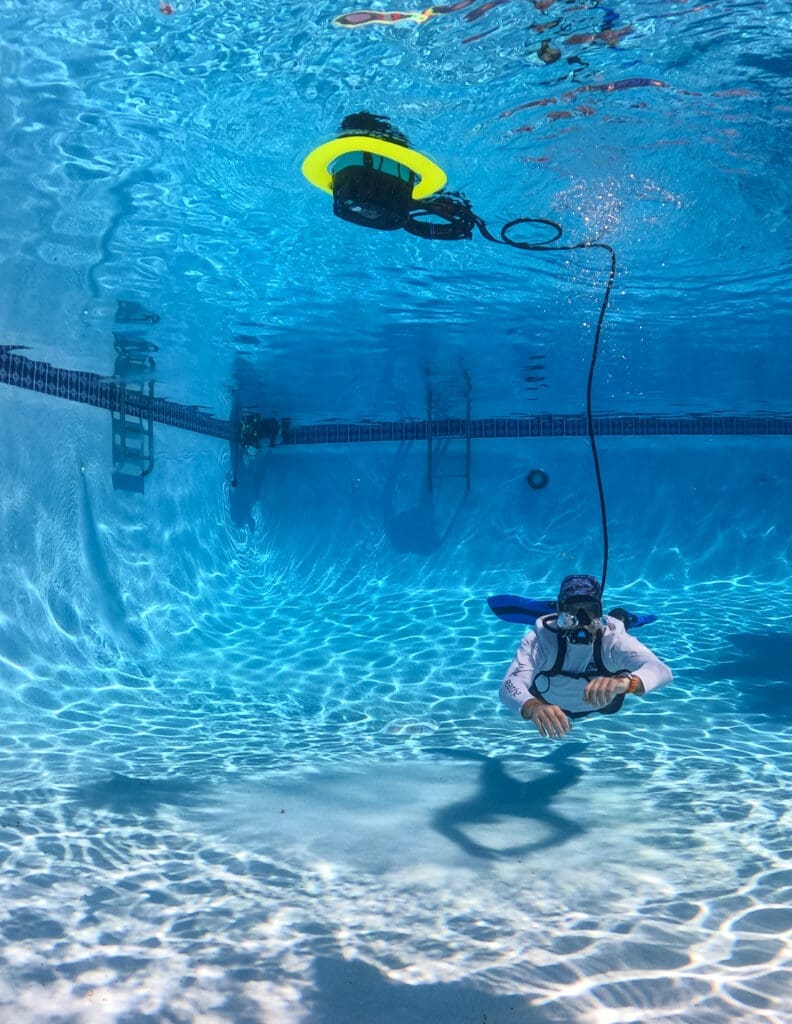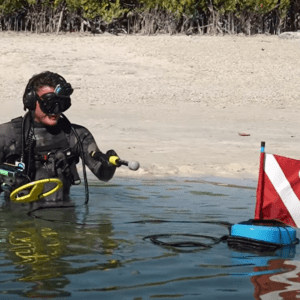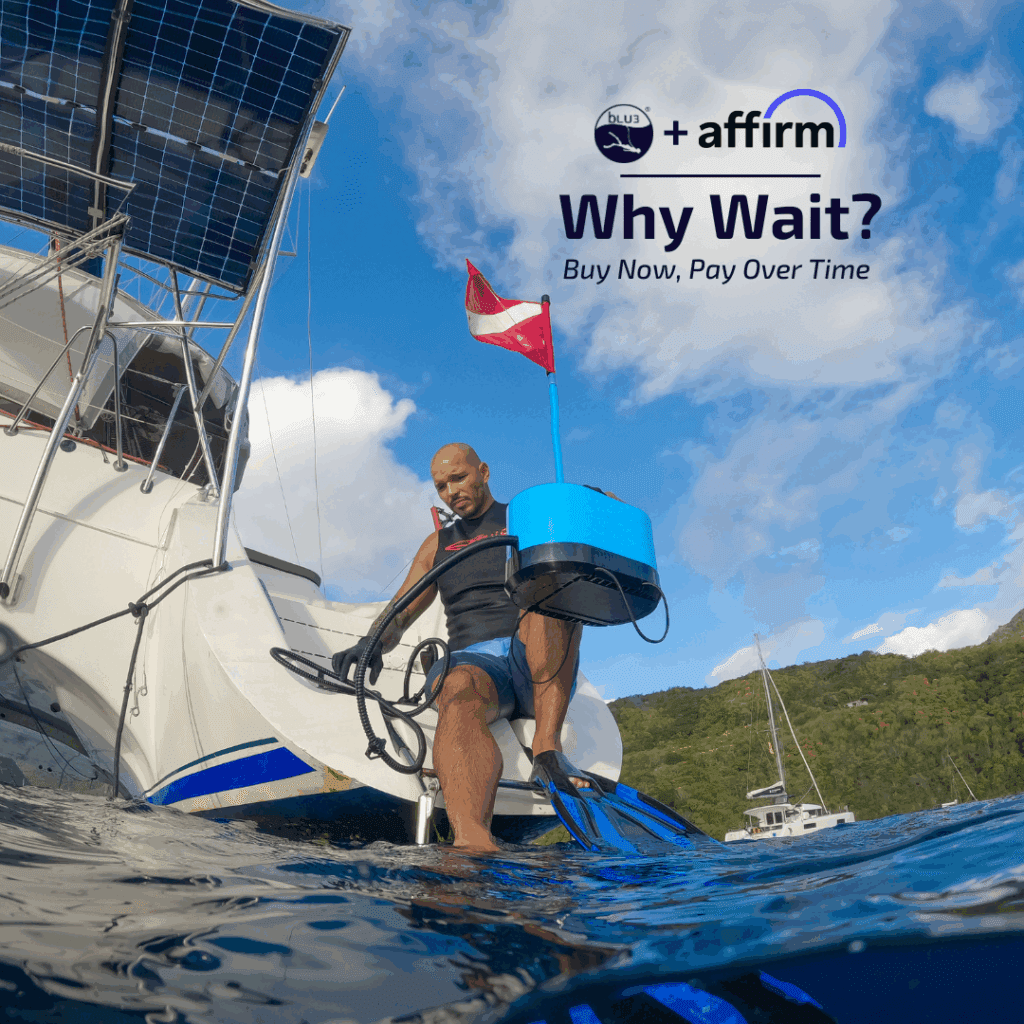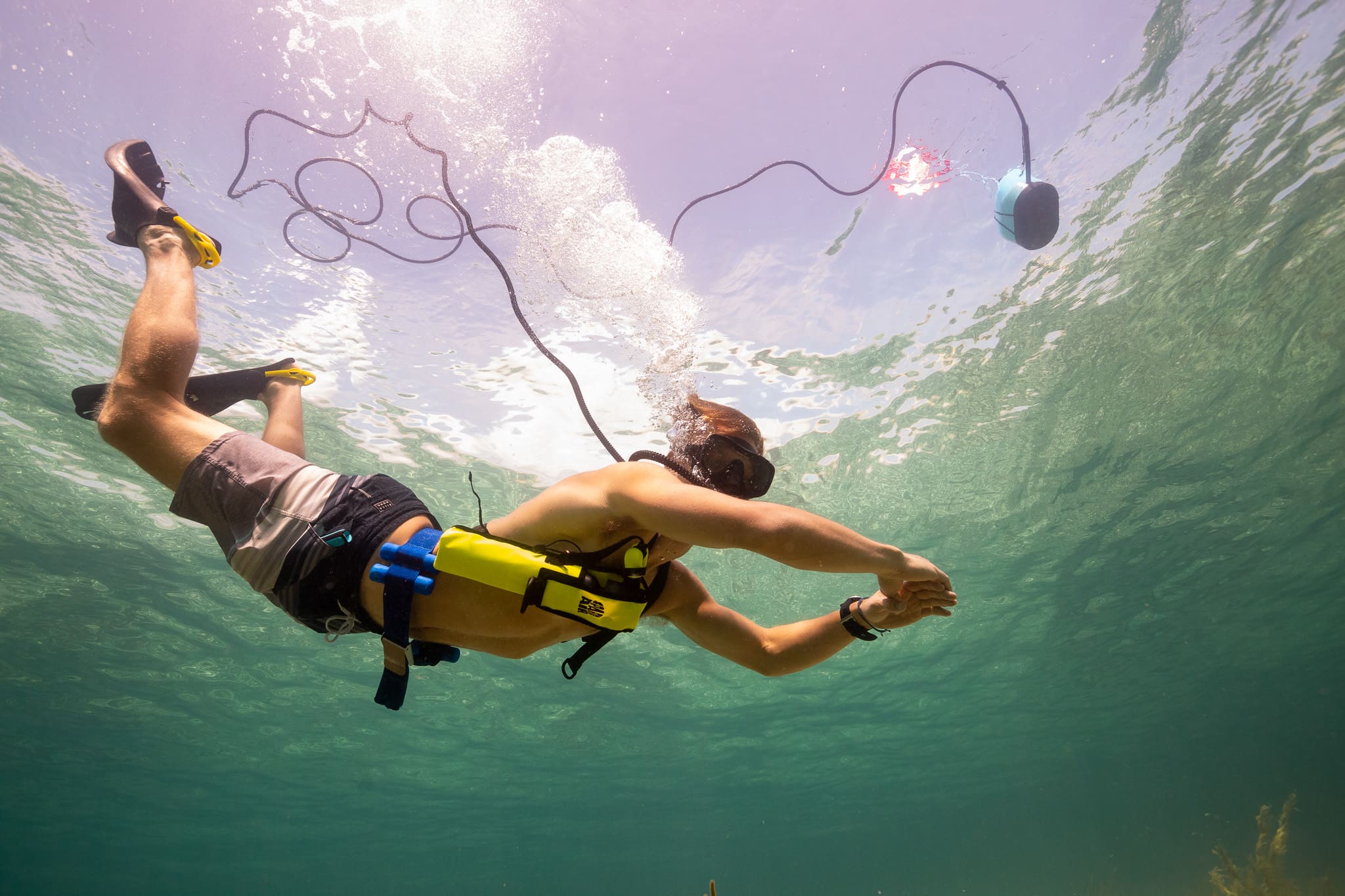What in the world is a ‘diving ventilator’? This odd term shows up online, mostly from overseas sellers of low quality devices, but what divers are really searching for is a portable tankless dive system, like those purpose built by BLU3. In any case, here’s the rundown on how these compare to scuba gear.

Picture yourself gliding through crystal-clear waters, exploring colorful reefs without the hassle of lugging around a heavy steel cylinder. Tankless dive systems, functioning as portable diving ventilators, make this dream a reality. This comparison breaks down how a tankless dive system stacks up against traditional scuba tanks in terms of mechanics, portability, depth limits, cost, ideal uses, and how to pick the right one for you. You’ll discover what powers BLU3’s Nomad and Nomad Mini, how conventional scuba gear works, which setup is best for your diving adventures, and how each choice helps to explore our oceans.
In this guide, we’ll cover:
- What a tankless dive system is and how it operates as a diving ventilator
- The basics of traditional scuba diving and its essential gear
- How portability and convenience differ for travel and boating
- Variations in depth limits and dive durations
- The costs involved in ownership and maintenance
- Ideal diver profiles and specific use-case scenarios
- A straightforward framework to help you choose the right system
What Is a Tankless Dive System (Portable Diving Ventilator) and How Does It Work?
A tankless dive system is essentially a compact, battery-powered air compressor that supplies breathing air through a hose and regulator, eliminating the need for bulky, pressurized tanks. It draws in ambient air, compresses it on demand, and delivers it to the diver. BLU3’s systems compress air immediately on-demand, with a maximum depth rating of up to 30 feet while removing the logistical headache of tank refills. This system functions as a portable diving ventilator, delivering air from the surface to the diver as-needed.
This innovative on-site air compression method simplifies your gear and makes diving more convenient, setting the stage to explore BLU3’s Nomad models in detail.
What Are the Features of BLU3 Nomad and Nomad Mini?
Before we dive deeper, let’s highlight the key specifications for both models and their standout benefits.
The following table clearly outlines the main differences between the BLU3 Nomad and Nomad Mini diving ventilator products:
| System | Feature | Benefit |
|---|---|---|
| Nomad | Depth rating: 30 ft | Allows for exploration at moderate depths |
| Nomad | Run time: up to 45-60 minutes | Supports longer, more enjoyable recreational dives |
| Nomad | Weight: 15 lb (includes battery) | Significantly reduces the strain of lifting compared to traditional scuba tanks |
| Nomad Mini | Depth rating: 15 ft | Perfect for snorkelers and shallow-water tasks |
| Nomad Mini | Run time: 35-40 minutes | Ideal for quick underwater jobs or pool sessions |
| Nomad Mini | Weight: 12 lb (includes battery) | Maximizes portability for easy transport and use anywhere |
This feature breakdown illustrates how each BLU3 model is designed to meet specific diving needs. While the Nomad is built for deeper, longer dives, the Nomad Mini prioritizes ultra-light convenience for shallow adventures. A further comparison of diving ventilators can be found here.
How Does Air Delivery Differ in Tankless Diving Ventilator Systems Compared to Scuba Tanks?
Tankless dive systems deliver air from the environment at a relatively low pressure using a gasoline-powered or an electric or battery-powered compressor, whereas traditional scuba tanks store air at high pressure, which is then regulated down for breathing. Tankless systems provide airflow until the battery runs out. The presence of low-battery indicators vary from one product to the next. BLU3’s Nomad and Nomad Mini feature a noticeable pulsating behavior when the battery runs low. In contrast, scuba tanks start at around 3,000 psi and gradually decrease in pressure, requiring divers to constantly monitor their gauges and manage air levels to avoid running low.
This fundamental difference in air delivery significantly impacts how divers plan their excursions and stay aware of their surroundings, leading us to the distinct advantages that tankless systems offer.

What Are the Advantages of Using a Tankless Dive System?
Tankless dive systems enhance diver freedom and simplify logistics in three key ways:
- Boost mobility by eliminating the need for heavy cylinders and valve assemblies
- Streamline pre-dive preparation by removing the requirement for tank fills or large compressors
- Encourage spontaneous diving adventures with simple battery charging and setup
These benefits make diving operations smoother for boat owners, underwater photographers, and casual snorkelers, opening up new possibilities for observing marine life and carrying out lightweight conservation tasks.
What Are the Limitations of Tankless Dive Systems?
While tankless systems offer superior convenience, they do come with certain limitations:
- Depth is restricted to 15–30 feet, depending on the specific model
- Battery life limits runtime to 35-60 minutes per charge, although batteries are very easy to swap out on BLU3 and Brownie’s Third Lung Sea Lion products in particular (others are not so easy)
- Note: The Brownie’s Third Lung Sea Lion has a run time of up to 3+ hours, which is far more dive time than a traditional scuba tank setup.
Understanding these constraints is crucial for dive planning and helps in deciding between BLU3’s Nomad and more traditional scuba setups.
Distinguishing BLU3 from Lower-Quality Alternatives
The market for underwater breathing devices includes a wide range of products, from reputable systems like BLU3 to lower-quality alternatives sourced from overseas. It’s important to understand the key differences to ensure an enjoyable diving experience.
| Feature | BLU3 Systems | Lower-Quality Alternatives |
|---|---|---|
| Purpose & Materials | Purpose-built for diving with non-toxic materials suitable for breathing. | Often repurposed components (e.g., tire inflators) not designed or tested for breathing. Material safety is questionable. |
| Specifications & Performance | Real, verifiable specifications. Consistent airflow suitable for wider range of depths and activity levels. Extensive real-world usage videos. BLU3 Dive Guide trained staff. | Often misleading or photoshopped marketing. Restricted airflow, making breathing difficult at depth. Limited real-world performance, suitable only for very shallow, low-activity use. |
| Size & Portability | Patented Smart Reg technology enables industry-leading small size and portability. | Generally larger and less portable due to less advanced technology. |
| Experience & Reliability | Backed by over 50 years of experience through parent company Brownie’s Marine Group (surface supplied dive systems since 1969). Proven reliability. | Limited or no established track record. Reliability is often unproven. Mass-produced imports with no direct human support or service. |
| Training & Support | Includes comprehensive BLU3 Online Dive Training Course. Accessible, real customer support based in the U.S. | Minimal or no training provided. Support is often difficult to find or non-existent. |
| Warranty & Service | Proper warranty and dedicated service program. | Little to no warranty or after-sales service. Customers frequently report lack of support or unresolved issues. Fake reviews are common, while real reviews often highlight dissatisfaction. |
When choosing an underwater breathing system, prioritizing safety, performance, and reliable support is paramount. BLU3 systems are engineered for reliability, supported by real training and service, and designed with features not found in lower-cost alternatives.
What Is Traditional Scuba Diving and How Do Scuba Tanks Work?
Traditional scuba diving relies on high-pressure cylinders filled with compressed air or specialized gas mixtures. These cylinders are connected to regulators that reduce the pressure to a breathable level. Divers depend on the tank’s capacity and pressure gauges to monitor their remaining air supply, and they require surface support for refilling tanks and regular, rigorous maintenance.
This well-established method forms the foundation of most recreational and technical dive training programs worldwide.
What Are the Main Components of Traditional Scuba Gear?
The core scuba gear setup includes:
- A durable steel or aluminum cylinder, typically filled to around 3,000 psi (200 bar)
- A first-stage regulator that attaches to the tank valve
- A second-stage demand valve with a comfortable mouthpiece
- A buoyancy control device (BCD) to manage neutral buoyancy underwater
- A pressure gauge and dive computer for monitoring air supply and depth
When combined with proper training and certification, these integrated components enable controlled dives to significant depths.
What Are the Benefits of Using Traditional Scuba Tanks?
Scuba tanks offer three primary advantages:
- They allow dives to depths of 100 feet or more when using appropriate gas blends and training
- They provide extended bottom times, often exceeding 45 minutes per dive
- They are supported by a vast global network of certification agencies and refill stations
These strengths solidify scuba’s position as the go-to method for deep exploration and technical diving disciplines.
What Are the Drawbacks of Traditional Scuba Tanks?
Despite their advantages in depth and duration, scuba tanks do present some challenges:
- They typically weigh 30 pounds or more, making travel and storage on boats more cumbersome
- They require regular hydrostatic testing, inspections, and servicing by certified technicians
How Do Tankless Dive Systems and Traditional Scuba Tanks Compare in Portability and Convenience?
Portability is often a key factor in choosing a dive setup, especially for travelers and boat owners. Tankless dive systems compress air right where you are, while scuba tanks need to be transported, secured, and refilled at specialized facilities.
Comparing these two approaches highlights their respective advantages for travel and ease of use.
Why Are Tankless Systems More Portable for Travel and Boating?
Tankless dive systems can be packed into a single carry case, weighing under 15 pounds. In contrast, scuba tanks require separate racks and storage solutions. Transporting a BLU3 Nomad involves simply removing the battery and managing the hose, avoiding the special handling fees often associated with pressurized containers on flights. This compression-on-demand technology eliminates shipping complexities and allows for immediate use upon arrival.
National Oceanic and Atmospheric Administration (NOAA), “Scuba Diving Safety” (2024)
This level of travel convenience revolutionizes spontaneous underwater exploration and makes it easy to conduct on-board conservation tasks without worrying about tank storage.
How Does Equipment Bulk Affect Setup and Transport?
A direct comparison of the equipment reveals:
- Tankless dive system: 1 compressor unit + hose + battery (12–15 lb total)
- Scuba setup: cylinder + regulator + BCD + weights (30–40 lb total)
By reducing the number of gear pieces and the overall weight, tankless systems allow for quicker, single-person setup and minimize loading times, making them versatile for many different applications.

What Are the Differences in Depth and Dive Duration Between Tankless and Scuba Systems?
The capabilities for depth and dive duration are directly tied to how air is supplied—whether through battery-powered compression or from the volume within a cylinder.
How Deep Can You Dive with a Tankless Dive System?
Tankless dive system models are designed for diving up to their specified depths:
- BLU3 Nomad: Maximum depth of 30 feet
- Nomad Mini: Maximum depth of 15 feet
Exceeding these limits can lead to insufficient air pressure and potential supply interruptions. Traditional scuba tanks, on the other hand, allow certified divers to reach depths of 100 feet or more, especially when using mixed gases under proper training.
Understanding these depth limitations is key to selecting the right equipment for your intended dive profiles.
How Does Dive Time Vary Between Tankless Systems and Scuba Tanks?
Dive duration is primarily determined by how the air supply is managed:
- Tankless systems: Battery life dictates the dive time: 35-40 minutes for the Mini, and 45-60 minutes for the Nomad, depending on diver depth and activity level
- Scuba tanks: Cylinder capacity determines bottom time—typically ranging from 45 to 60 minutes with a standard 80 cubic foot tank
Battery-powered systems eliminate the need for mid-dive refills, while scuba cylinders require access to surface support and fill stations. These differences significantly influence planning for multi-dive tours and spontaneous diving trips.
How Do Cost and Maintenance Compare Between Tankless Dive Systems and Traditional Scuba Tanks?
Examining the initial purchase price and long-term servicing costs provides a clear picture of the total cost of ownership for both options.
What Are the Initial Purchase Costs for Each System?
The initial investment varies depending on the equipment chosen:
- BLU3 Nomad system package: approximately $2,199
- Nomad Mini system package: approximately $1,649
- Standard scuba package (including tank, regulator, BCD): $1,200–$1,800, but all-in can be even higher
While tankless systems represent a significant upfront cost, their convenience and integrated charging solutions can offset the ongoing expenses associated with cylinders and fill station access.
What Are the Ongoing Costs for Refills, Servicing, and Certification?
Ongoing expenses include:
- Tankless systems: Battery replacements every 5+ years and periodic inspections which are free at BLU3
- Scuba tanks: Cylinder fills ($5–$10 per fill), hydrostatic tests every 5 years ($50–$100), and regulator servicing ($60 annually)
When considering the entire lifecycle of the equipment, these ongoing costs can make tankless systems more economical for divers who frequently explore the underwater world or have limited access to air fill stations.
How Do Certification and Training Expenses Differ?
The required training significantly impacts the overall cost:
- Tankless diving: While formal certification is not typically required for shallow, recreational use, comprehensive operational training and adherence to manufacturer guidelines are essential for enjoyable operation as a diving ventilator. Scuba certification is recommended.
- BLU3 Online Dive Training Course is free to anyone.
- Scuba diving: An open-water certification course typically costs $400–$600.
What Are the Safety Considerations for Tankless Dive Systems vs. Traditional Scuba Tanks?
Safety protocols and emergency procedures differ based on the method of air delivery and the system’s depth capabilities. Diving inherently involves risks, and proper training and adherence to operational procedures are essential for all underwater activities.
Is Tankless Diving Safe for Recreational Use?
Tankless diving, particularly with systems like the BLU3 Nomad, can be utilized for recreational purposes when divers adhere to manufacturer guidelines, monitor battery levels, and remain attentive to the floating compressor unit at the surface. Proper training and adherence to operational procedures are paramount for any diving activity.
One of the most critical rules, emphasized in the BLU3 Online Dive Training Course, is to never hold your breath while diving. Breath-holding can lead to serious injury, and continuous breathing is a fundamental safety requirement regardless of depth.
By approaching these systems with preparation, responsibility, and a commitment to core diving principles, trained divers can make informed choices while remaining aware of the limits and risks involved in shallow and moderate-depth dives.
Who Should Choose a Tankless Dive System or Traditional Scuba Tanks?
The decision of which air system to choose ultimately depends on the diver’s profile, the type of activities planned, and personal preferences for planning and logistics.
Which Divers Benefit Most from Tankless Dive Systems?
Tankless systems are an excellent choice for:
- Boat owners who need to perform quick underwater inspections or hull cleaning
- Underwater photographers who require maximum freedom of movement and minimal drag
- Pool maintenance professionals who need portable air supply for service tasks
- Treasure hunters or metal detector users working in shallow water environments
- Marine biologists and conservation volunteers conducting reef surveys or monitoring projects
- Fossil hunting, gold sniping, travel diving, simple shore diving, and so much more!
The streamlined design and straightforward setup cater perfectly to spontaneous diving adventures and convenience-focused underwater experiences.
Who Is Best Suited for Traditional Scuba Diving?
Traditional scuba diving is ideal for:
- Advanced recreational divers who want to explore deeper reefs or shipwrecks
- Technical divers who venture beyond 60 feet and utilize mixed gases
- Divers exploring caves or other areas with overhead obstructions
Certified divers gain access to extensive training resources, a worldwide refill infrastructure, and the ability to explore much greater depths.
How Can You Choose the Right Dive System for Your Needs?
A structured approach to evaluating your goals, experience level, and logistical needs will ensure you select the most suitable dive system.
What Factors Should You Consider When Selecting a Dive System?
Consider these key criteria:
- Your target depth and desired bottom time
- How often you travel and your constraints on gear transport
- Preference for refilling scuba tanks versus charging batteries
By carefully evaluating each factor, you can determine whether a tankless model, functioning as a portable diving ventilator, or a conventional scuba rig best fits your diving lifestyle and aspirations.
How Do BLU3 Products Fit Different Diver Profiles?
BLU3’s product line is designed to meet a variety of diver needs:
- Recreational boaters and divers often find the Nomad ideal for dives up to 30 ft and durations of up to 60 minutes. Explore the full feature set of the Nomad here.
- Metal detectorists and pool technicians typically opt for the Nomad Mini, perfect for lightweight, 15 ft dives lasting up to 40 minutes—discover the Nomad Mini specifications here.
These models are tailored for convenience in shallow waters and exploration at moderate depths.
Where Can You Learn More and Purchase BLU3 Tankless Dive Systems?
To explore BLU3’s innovative portable dive solutions and accessories, visit the official product pages:
- Explore the BLU3 Nomad diving ventilator system for dives up to 30 feet
- Discover the Nomad Mini portable diving ventilator systems for dives 15 feet and less
These pages offer detailed specifications, user guides, and purchasing options to help you gear up for your next underwater journey.
Tankless dive systems and traditional scuba tanks each offer unique advantages for different diving styles. Tankless technology, functioning as a portable diving ventilator, enhances portability and simplifies logistics, while scuba tanks provide proven depth capabilities for more serious explorations. By carefully assessing your depth goals and how much value you place on portability and convenience, you can choose the dive system that best aligns with your underwater aspirations. BLU3’s innovative Nomad and Nomad Mini diving ventilator models offer tailored solutions for recreational boaters, photographers, snorkelers, and conservation enthusiasts, empowering hassle-free diving experiences.

